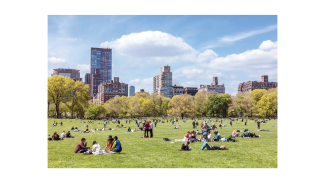Return on investment in equitable communities
Explore resources and talking points on the financial opportunities and benefits of investing in equitable communities to help support architects and the communities they serve.

Investing in equitable communities
Underserved communities are diverse and occur in rural, island, tribal, urban, and other settings. Lessons learned in one area may be applicable to others; one size does not fit all, but there are potential lessons to be learned from each.
Similarly, diversity exists within each community, let alone between communities, and understanding the community where one is working is a foundational first step. Communities comprise individuals with their own priorities; grouping them can be problematic or difficult.
These resources and talking points provide examples that may be adaptable to various circumstances. They aim to provide a base-level understanding of the financial opportunities and benefits of working in equitable communities to help support architects and those they serve.
The Urban Institute suggests using the term “priority communities” to describe communities that “have been historically marginalized, overburdened, and underserved. This includes communities facing persistent poverty, communities burdened by environmental stressors, and communities with high rates of racial and ethnic residential segregation.” The group also recommends asking the community to identify its preferred language since there is likely no single term that resonates with all the communities being addressed.1 Other terms for such communities include the federal government’s description, “disadvantaged communities,” “marginalized communities,” or AIA’s usage, “underserved communities,” and “equitable communities.” For the purposes of this research, we have chosen to utilize the terms “equitable communities" and “underserved communities.” The Guides for Equitable Practice includes a glossary of terms, as does Illume Advising. These may be useful guides and references for this work.
AIA has developed several excellent guides for developing, creating, and advocating for equitable communities and firm-wide equitable practices, including AIA Guides for Equitable Practice, Architect’s Role in Creating Equitable Communities, Equitable Development Frameworks, and the Framework for Design Excellence: Design for Equitable Communities. The following provides equitable development strategies for architects and others seeking to increase investments in communities and firms.

Community talking points
Community investments support social, individual, and economic ecosystems. When equitable, these investments provide direct economic and positive social benefits to communities and their residents. The benefits of investment and resulting returns on investments (ROI) in underserved communities are complex and multifaceted and go beyond narrow financial terms and timeframes. Successful outcomes often necessitate a generational investment in social, human, and economic sustainability that cannot be defined only with an immediate ROI but must be measurable in terms of long-term community economic development and other social benefits with significant value.2 These returns should be structured to reinvest broadly in communities to benefit local resident stakeholders and build long-term physical and economic resilience.
The economic, health, and social costs associated with lack of investment in affected communities have been extensively documented,1 implicating many facets of society, including access to and quality of education and health care, social mobility, and public safety, among others. The economic, health, and environmental conditions in underserved communities are often the historic remainders and ongoing perpetuation of racist policies and entrenched power disparities.2
- The historical practice of redlining neighborhoods of color, combined with ongoing disinvestment in these same neighborhoods, not only resulted in limited economic opportunities for residents, but also led to increased exposure to extreme heat, stemming in some cases from the siting of industrial facilities in these neighborhoods.2
- In 2022, Deloitte estimates that inequities in the U.S. health system cost approximately $320 billion per year.3
- Investments in education have shown a 9-to-1 benefit-cost ratio.4
- Studies have shown a 21% decrease in crime associated with structural housing repairs.5
References:
- World Health Organization. “Closing the Gap in a Generation: Health Equity Through Action on the Social Determinants of Health.” 2008.
- Fu, Smantha, Ladi Williams, James & Shipp, Anna. “Advancing Equity, Climate Action, and Economic Health in Communities: Challenges and Opportunities for the Justice40 Initiative.” 2002.
- Batra, Neal, Dr. Bhatt, Jay, Davis, Andy, & Dhar, Asif. “US Health Care Can’t Afford Health Inequities.” Deloitte Insights. 2022.
- Epstein, Diana. “Investing in Education Powers U.S. Competitiveness.” Center for American Progress. 2011.
- South, Eugenia C. MacDonald, John, & Reina, Vincent. “Association Between Structural Housing Repairs for Low-Income Homeowners and Neighborhood Crime.” Public Health. 2021.
Buildings and communities are subjected to destructive forces from natural and human-caused hazards such as fire, earthquakes, flooding, sea level rise, tornadoes, tsunamis, severe weather, and even intentional attacks. The forces affecting the built environment are evolving with climate change, environmental degradation, population growth, and migration; this alters long-term conditions and demands design innovation.1
- Climate vulnerability and the adaptive capacity of urban residents and communities are influenced by pronounced social inequalities that reflect age, ethnicity, gender, income, health, and (dis)ability differences.2 The communities that bear the brunt of the climate crisis are often the most vulnerable and marginalized and disproportionality represent the poorest; simultaneously, their livelihoods and outcomes are more climate dependent.3
- Enabling traditionally underserved communities to have greater economic resilience will help bolster their ability to successfully weather shocks and stressors exacerbated by climate change.2
- Regional economic prosperity is linked to an area’s ability to prevent, withstand, and quickly recover from major disruptions (i.e., “shocks”) to its economic base.4
- Community land trusts (CLTs) have been used to protect communities from displacement and increase resilience in coastal areas subject to hurricanes and the aftermath of significant storm damage. An example is the Caño Martín Peña Community Land Trust in San Juan, Puerto Rico. A recent case study outlines how a CLT protects vulnerable communities from market-driven displacement that often occurs after natural disasters.5
References:
- AIA Understanding Resilience Guide.
- “Fourth National Climate Assessment.” The U.S. Global Change Research Program. 2019.
- “How the regenerative economy can advance social equity and gender equality.” The World Economic Forum. 2023.
- “Comprehensive Economic Development Strategy Content Guidelines.” U.S. Economic Development Administration.
- Veronesi, Mariangela, Algoed, Lina, & Hernández Torrales, Maria E. “Community-Led Development and Collective Land Tenure for Environmental Justice.” International Journal of Urban Sustainable Development. 2022.
In regenerative development, holistic processes are applied to create feedback loops between physical, natural, economic, and social capital that are mutually beneficial and go beyond a typical application of sustainable development.
- Regenerative development has the capacity to restore equitable, healthy, and prosperous relationships between and among these systems. These practices require systems-level thinking, working within the bioregional context, and an emphasis on place-based solutions.1
- The question in regenerative development is “How can we solve this problem in such a way that we improve the capacity of the underlying support systems?”2
References:

Firm resources
Working with, and as part of, underserved communities can benefit firms. Supporting a process that enables projects to meet client and community needs and improving relationships within communities through partnerships and internal business practices, contributes to a market advantage and offers reputational benefits.3 Firms that have experience and successful outcomes working with underserved communities are better positioned to meet client demands in contexts where municipalities or other regulatory environments require navigating justice, equity, diversity, and inclusion goals.4
Engaging with underserved communities is a growth opportunity for firms.1 By building social and financial capital within their own community, firms can contribute to a sustainable local economic ecosystem.2
- Working in underserved communities creates the opportunity for teams to build practices, values, relationships, and experience, providing a foundation for further opportunities to engage and design in/within those and other communities.3
- Experience successfully engaging in an equitable process can help attract fruitful partnerships with owners, developers, consultants, and/or organizations within marginalized communities,3 enabling agility in the kinds of projects firms can take on.4
References:
- AIA Guides for Equitable Practice: Engaging Communities
- “Change for Good: Lessons from ULI’s District Council Task Forces for Health and Social Equity.” Urban Land Institute. 2021.
- Interview with Elaine Asal, Strategy Director at Gensler.
- “Design for Equity Primer: 20+ Resources to Help You Design Inclusively and Fairly.” Metropolis Magazine. 2022.
Companies may consider self-reporting environmental, social, and governance (ESG) metrics to reflect both an ethical and business sensibility about the firm’s practices, which can provide market differentiation or a competitive edge.1 Other companies, such as Fortune 500 companies or public entities that are subject to Securities and Exchange Commission (SEC) rules, require that their vendors, including architects and allied professionals, comply with SEC requirements, thereby limiting the firms from which they select.2
- Projects and firms that follow ESG benchmarking and reporting practices outperform their peers, while ESG reporting and metrics can set benchmarks for best practices across the industry.3 The SEC has indicated that companies will be graded and measured based on how they are doing against ESG indicators; lenders and insurers are also looking at these factors when setting their rates.1,3
- ESG investing can have a broad definition that includes environmental sustainability as well as social impact investment in underserved communities and a commitment to inclusion and diversity, both at the corporate level and within underwriting and investment practices.1
- In 2021, BlackRock CEO Larry Fink acknowledged that over the course of 2020, “purposeful companies, with better environmental, social, and governance profiles, have outperformed their peers.” In addition, being connected to stakeholders through trust-based relationships and acting with purpose “enables a company to understand and respond to the challenges happening in the world.”3
References:
- Melton, Paula. “ESG: 6 Things Building Professionals Need to Know.” BuildingGreen. 2022.
- Heather Burpee Interview with Molly McCabe & Hayden Tanner. 2022.
- Borland, Kelsi Maree. “Behind The Surge In ESG Commitments.” GlobeSt.com. 2021.
These partnerships can help support and grow minority- and women-owned businesses, establish partnerships, and build markets in underserved communities, supporting the ecosystems of small businesses. The value brought by having a diverse set of stakeholders can grow perspective and lead to a more well-rounded analysis of what is needed and valued in the community.1
- Utilizing community engagement practices in design, such as the co-design process, Social Economic Environmental Design(SEED), Enterprise Green Communities Certification, or the Center for Active Design’s Assembly Civic Design Guidelines among others, can lead to better outcomes with a greater value return than those that do not fully engage with community stakeholders or use a more traditional or prescribed model of community engagement.
- Firms can increase their attraction and retention of employees, many of whom are increasingly seeking employment where promoting/serving equitable communities is part of a firm’s mission and culture.4
- Firms can directly support businesses and the workforce within underserved communities via hiring, purchasing, and service practices.5
References:
- Heather Burpee Interview with Molly McCabe & Hayden Tanner. 2022.
- Roberts, Jess, Bright, Kevin, & Elkhalifa, Wafa. “Community Co-Design: Tools & Tactics, an Approach to Equitable Community Engagement and Action.” Community for Health of Rochester, Minnesota. 2022.
- Heather Burpee Interview with Jess Roberts of University of Minnesota.
- AIA Guides for Equitable Practice
- “Design for Equity Primer: 20+ Resources to Help You Design Inclusively and Fairly.” Metropolis Magazine. 2022.
Literature review completed by University of Washington’s Integrated Design Lab for AIA in 2023.
References:
- Fu, Samantha, Ladi Williams, James & Shipp, Anna. “Advancing Equity, Climate Action, and Economic Health in Communities: Challenges and Opportunities for the Justice40 Initiative.” Urban Institute. 2022.
- O’Roarty, Brenna. “Social Impact: Investing with Purpose to Protect and Enhance Returns.” 2022
- AIA Guides for Equitable Practice
- Roberts, Jess, Bright, Kevin, & Elkhalifa, Wafa. “Community Co-Design: Tools & Tactics, an Approach to Equitable Community Engagement and Action.” Community for Health of Rochester, Minnesota. 2022.


